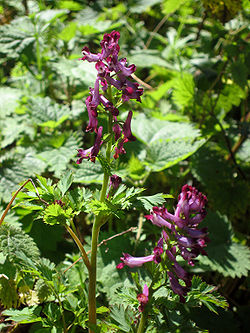en
names in breadcrumbs


Corydalis incisa, incised fumewort, is an annual or biennial herbaceous species of plant in the poppy family.[1] It is also known as purple keman or murasa-kike-man. Some authorities report it in the family Fumariaceae.[2] The wildflower is native to Japan, Korea, Taiwan, and China, found in forests, clearings, and irrigation channels.[3]
Incised fumewort is an introduced species in the United States, with populations in New York, Pennsylvania, Maryland, Virginia, West Virginia, North Carolina, Tennessee, and the District of Columbia.[2][4] The first reported populations were found in Bronx and Westchester Counties in 2005 and 2014. The plant can readily escape cultivation; it spreads from seeds explosively ejected from the fruit. The seed contains an elaiosome, which attracts dispersing ants. Apparently thriving in fine alluvial sediments, Corydalis incisa forms dense stands, crowding out more desirable riparian understory plants.[2][3][5]
Corydalis incisa, incised fumewort, is an annual or biennial herbaceous species of plant in the poppy family. It is also known as purple keman or murasa-kike-man. Some authorities report it in the family Fumariaceae. The wildflower is native to Japan, Korea, Taiwan, and China, found in forests, clearings, and irrigation channels.
Incised fumewort is an introduced species in the United States, with populations in New York, Pennsylvania, Maryland, Virginia, West Virginia, North Carolina, Tennessee, and the District of Columbia. The first reported populations were found in Bronx and Westchester Counties in 2005 and 2014. The plant can readily escape cultivation; it spreads from seeds explosively ejected from the fruit. The seed contains an elaiosome, which attracts dispersing ants. Apparently thriving in fine alluvial sediments, Corydalis incisa forms dense stands, crowding out more desirable riparian understory plants.
Cuzy kokorč (Corydalis incisa) je rostlina z podswójby kokrikowych rostlinow (Fumarioideae) znutřka makowych rostlinow (Papaveraceae).
Cuzy kokorč (Corydalis incisa) je rostlina z podswójby kokrikowych rostlinow (Fumarioideae) znutřka makowych rostlinow (Papaveraceae).
Corydalis incisa là một loài thực vật có hoa trong họ Anh túc. Loài này được (Thunb.) Pers. mô tả khoa học đầu tiên năm 1806.[1]
Corydalis incisa là một loài thực vật có hoa trong họ Anh túc. Loài này được (Thunb.) Pers. mô tả khoa học đầu tiên năm 1806.
刻叶紫堇(学名:Corydalis incisa)为罂粟科紫堇属下的一个种。
|access-date=中的日期值 (帮助)

ムラサキケマン(紫華鬘、学名:Corydalis incisa)はキケマン属の越年草。
茎は真っ直ぐに立ち、高さは30-50cmほど。茎には複数の葉がつき、それぞれ斜め上に伸びて2-3回3出複葉、小葉は扇形に近く、先端は丸くて、丸い鋸歯がある。葉質は薄くて柔らかく、つやを欠く。
花期は4-6月で、赤紫色の長さ2cmでキケマン属に独特の筒状の花を咲かせる。
果実は豆の果実に似る。
日本全国に分布し、国外では中国から知られる。木陰などの直射日光の当たらない場所に生育する。
一般にこの植物は越年草といわれるが、実際にはもう少し複雑な生活史を持っている。この植物の種子は6月頃に成熟するが、これは発芽するのは翌年の春で、初夏まで成長した後、地上部は枯れ、地下に団子状の塊茎を残す。
これが再び活動するのはその年の秋で、数枚の葉を出して年を越し、春になると花茎を立てて花をつけ、結実すると全体が枯れる。上記の特徴の説明はこの花時期のものである。
全草にプロトピンを含み有毒。誤食すれば嘔吐・呼吸麻痺・心臓麻痺などを引き起こす。 ウスバシロチョウの幼虫の食草であり、このためウスバシロチョウも有毒となる。また、植物体を傷つけたときに出る汁は悪臭がする。だが、実際に茎を折って匂いをかいでみると、特に臭いの感じられない個体も多い。 山菜であるシャク (植物)と生育場所や葉の形が非常によく似ているため、注意が必要である。
花の形が独特なので、他の仲間と間違うことはない。同属にはジロボウエンゴサク等のエンゴサク類とキケマン類がある。前者は地下に塊茎を持つ小柄な植物であり、後者は黄色い花を持つ大柄な植物なので見分けに困ることはない。
帰化植物ではカラクサケマンがやや似ているが、より小型で、蔓のようにはい回る。
자주괴불주머니(Corydalis incisa)는 현호색과의 식물이다. 두해살이풀로서 줄기의 높이는 50cm 가량이다. 뿌리잎은 2회 3출겹잎인데, 작은잎은 더 불규칙하게 갈라져 있다. 꽃은 좌우대칭의 통꽃으로, 4개의 꽃잎 가운데 바깥둘레의 위쪽 꽃잎 밑부분은 떨어져 있다. 6개의 수술은 3개씩 합쳐져 있다. 4-6월경에 여러 개의 홍자색 꽃이 줄기 끝에 총상꽃차례를 이루면서 달린다. 열매는 삭과로 8-9월에 익는다. 주로 산이나 들의 그늘진 습지에 많으며 제주·전남·전북 등지에 분포하고 있다.
자주괴불주머니(Corydalis incisa)는 현호색과의 식물이다. 두해살이풀로서 줄기의 높이는 50cm 가량이다. 뿌리잎은 2회 3출겹잎인데, 작은잎은 더 불규칙하게 갈라져 있다. 꽃은 좌우대칭의 통꽃으로, 4개의 꽃잎 가운데 바깥둘레의 위쪽 꽃잎 밑부분은 떨어져 있다. 6개의 수술은 3개씩 합쳐져 있다. 4-6월경에 여러 개의 홍자색 꽃이 줄기 끝에 총상꽃차례를 이루면서 달린다. 열매는 삭과로 8-9월에 익는다. 주로 산이나 들의 그늘진 습지에 많으며 제주·전남·전북 등지에 분포하고 있다.